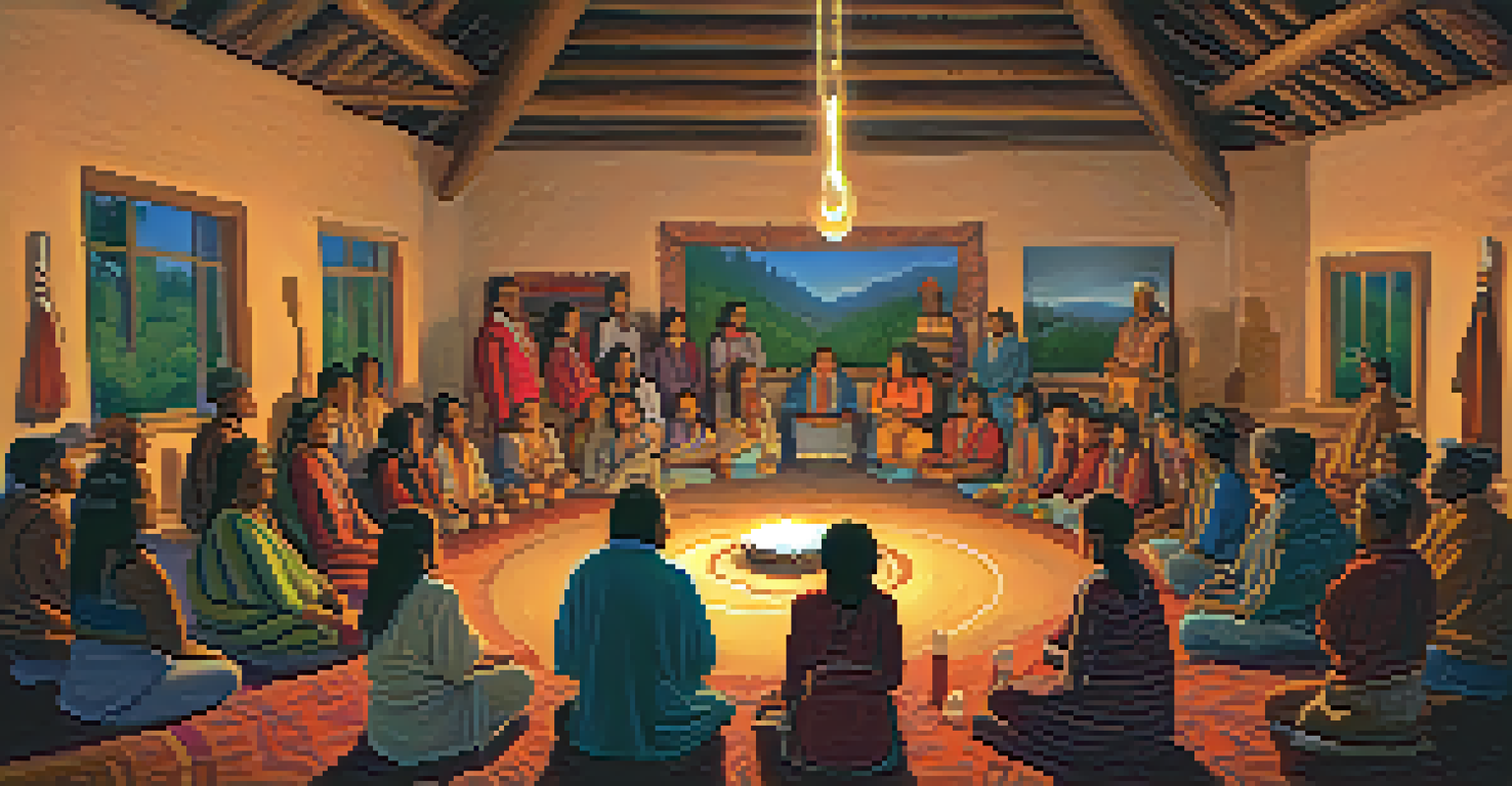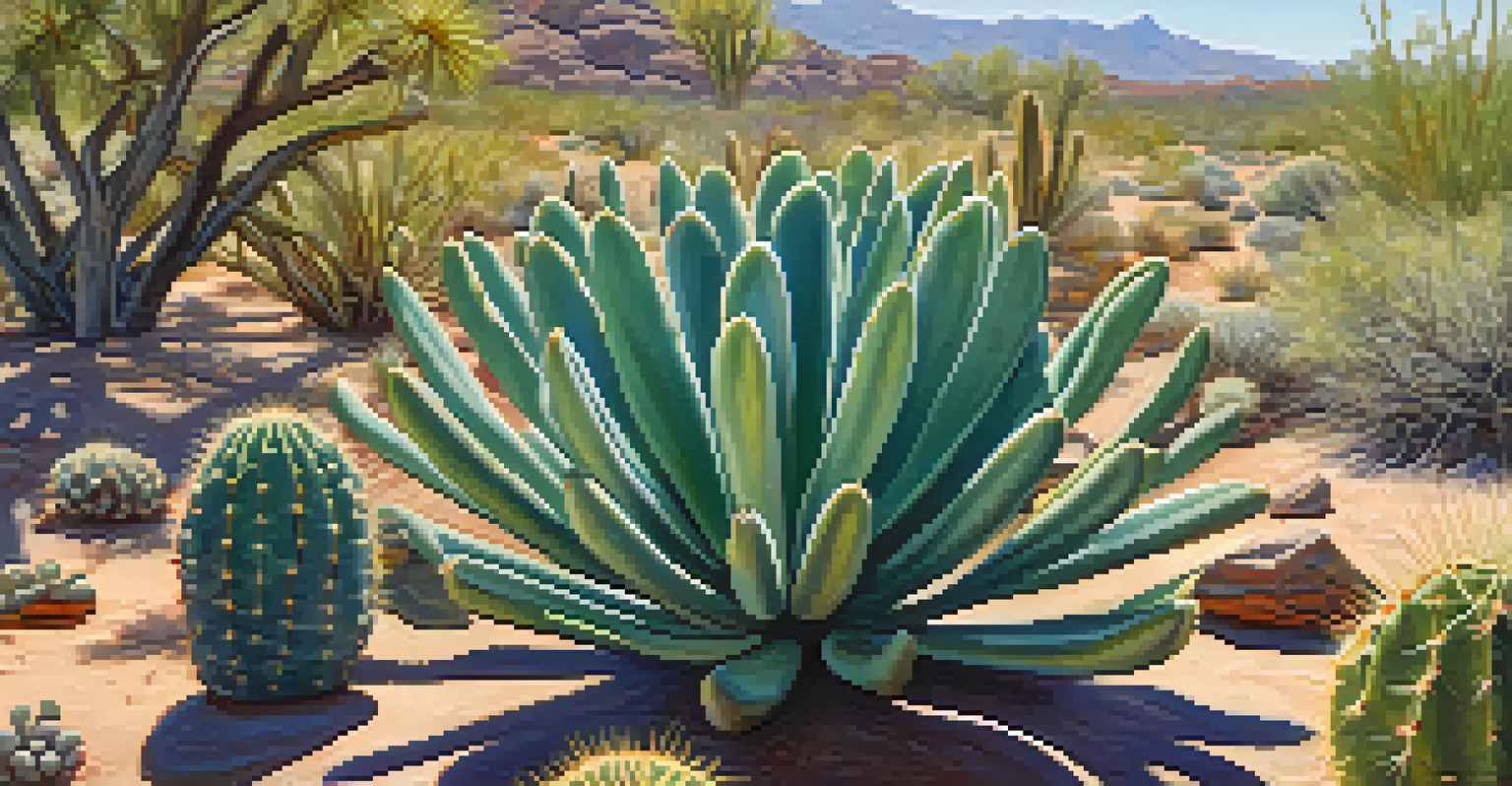Ceremonial Use of Peyote: A Guide to Traditional Practices

Understanding Peyote: A Cultural and Spiritual Icon
Peyote is a small cactus native to the deserts of Mexico and the southwestern United States. It has been used for centuries by Indigenous peoples for its psychoactive properties and spiritual significance. The cactus contains mescaline, a compound that induces altered states of consciousness, making it a central element in various ceremonial practices.
The use of peyote is not just a means to an end, but a pathway to understanding our place in the universe.
For many Native American tribes, peyote serves as a bridge to the spiritual world, facilitating communication with ancestors and the divine. The ceremonies often involve singing, drumming, and prayer, creating a communal atmosphere that strengthens bonds among participants. This shared experience fosters a deep sense of connection to one another and the natural world.
Additionally, peyote is not merely a tool for personal exploration; it embodies a rich cultural heritage. The rituals surrounding its use are steeped in tradition and are often passed down through generations, showcasing the resilience and continuity of Indigenous cultures in the face of modern challenges.
The Role of Peyote in Native American Church Ceremonies
The Native American Church (NAC) plays a significant role in the ceremonial use of peyote, merging Indigenous traditions with Christian practices. Established in the early 20th century, the NAC provides a legal framework for the use of peyote in religious ceremonies, emphasizing its importance for spiritual healing and personal growth.

During NAC ceremonies, participants gather in a sacred space, often referred to as a 'meeting house.' The ceremony typically includes the ingestion of peyote, singing of hymns, and communal prayers. This structured approach helps participants navigate their experiences, fostering a sense of safety and support within the group.
Peyote's Spiritual Role in Cultures
Peyote serves as a vital spiritual tool for Indigenous peoples, facilitating connections with the divine and fostering communal bonds.
Moreover, the NAC emphasizes the importance of respect for peyote as a sacred entity. Members are taught to approach their use of the cactus with reverence, understanding its role not just as a substance, but as a spiritual guide that can lead to profound insights and healing.
Spiritual Significance of Peyote in Indigenous Cultures
Peyote holds profound spiritual significance for many Indigenous cultures, acting as a conduit for spiritual insight and healing. The ceremonies surrounding its use often involve deep introspection, allowing participants to confront personal struggles and seek guidance from the spirit world. This journey can lead to transformative experiences, promoting emotional and psychological well-being.
To honor the sacred is to recognize the interconnectedness of all life.
In many tribes, peyote is viewed as a gift from the Creator, symbolizing a sacred connection to nature. This belief fosters a deep respect for the environment and encourages sustainable practices, as the cactus itself is considered a part of the larger ecosystem. By honoring peyote, Indigenous peoples also honor the land that sustains them.
Additionally, the use of peyote can serve to strengthen cultural identity and community ties. As participants come together to engage in these ceremonies, they reinforce their shared values and histories, creating a sense of belonging that transcends individual experiences.
Rituals and Practices Involved in Peyote Ceremonies
Peyote ceremonies typically follow a structured format, ensuring that participants can fully engage in the experience. The ritual often begins with a prayer and an offering, acknowledging the sacredness of the cactus and the intentions behind its use. This sets the tone for the evening, creating a respectful environment for reflection and connection.
Participants usually consume peyote in a communal setting, where they share stories, songs, and prayers throughout the night. The use of drumming and singing not only enhances the spiritual atmosphere but also helps participants synchronize their energies, fostering a sense of unity. This collective experience can amplify the effects of the peyote and deepen the overall journey.
Health Benefits of Peyote Use
Peyote is recognized for its potential mental health benefits, offering emotional healing and clarity in a supportive communal setting.
As the night progresses, participants may enter different stages of awareness, guided by the ceremonial leaders. These leaders, often elders or experienced members, provide support and guidance, ensuring that everyone feels safe and respected as they navigate their individual journeys.
Health Benefits and Healing Aspects of Peyote Use
Beyond its spiritual implications, peyote has been recognized for its potential health benefits, particularly in mental health contexts. Many participants report experiences of emotional release, insight, and clarity, which can contribute to healing from trauma or addiction. This therapeutic aspect has garnered interest from researchers exploring the broader implications of psychedelics in mental health treatment.
The communal aspect of peyote ceremonies also plays a crucial role in the healing process. As participants share their experiences, they often find solace in the understanding and support of others who have faced similar challenges. This sense of community can be a vital component in overcoming personal struggles and fostering resilience.
Moreover, the use of peyote in traditional settings emphasizes the importance of holistic healing. It combines spiritual, emotional, and sometimes physical healing practices, recognizing the interconnectedness of these aspects in achieving overall well-being.
Legal Status and Contemporary Challenges of Peyote Use
The legal status of peyote varies widely across different regions, complicating its use in traditional ceremonies. In the United States, the American Indian Religious Freedom Act allows for the use of peyote in religious contexts, but this privilege is not universally recognized. Some Indigenous communities face significant challenges in accessing this sacred plant due to restrictive laws and regulations.
Contemporary challenges also include the environmental sustainability of peyote harvesting. Overharvesting and habitat destruction threaten this sacred cactus, prompting concerns about its future availability for ceremonial use. Many Indigenous groups are advocating for sustainable practices and legal protections to ensure the survival of peyote for future generations.
Challenges Facing Peyote Traditions
Legal restrictions and environmental concerns pose significant challenges to the traditional use of peyote, threatening its availability and cultural practices.
Furthermore, the increasing interest in psychedelics for therapeutic purposes raises questions about cultural appropriation and respect for Indigenous practices. As more people seek out peyote experiences, it's crucial to honor the traditions and teachings of the Indigenous communities that have nurtured and safeguarded this sacred plant for centuries.
Preserving Traditional Practices: The Future of Peyote Use
Preserving traditional peyote practices involves a commitment to cultural education and advocacy within Indigenous communities. Efforts are underway to pass down knowledge and rituals to younger generations, ensuring that the spiritual significance of peyote remains alive. This transmission of knowledge is vital for maintaining cultural identity and fostering resilience in the face of modern challenges.
Additionally, many Indigenous leaders are actively engaging in dialogues about the future of peyote use, focusing on sustainability and legal protections. By advocating for policies that respect Indigenous rights and practices, they aim to create a supportive environment for future ceremonial use of peyote. This proactive approach is essential for the survival of both peyote and the cultural practices associated with it.

Ultimately, the future of peyote use lies in the balance between honoring traditional practices and adapting to contemporary realities. By fostering a respectful understanding of peyote's significance, we can all participate in preserving this sacred practice for generations to come.